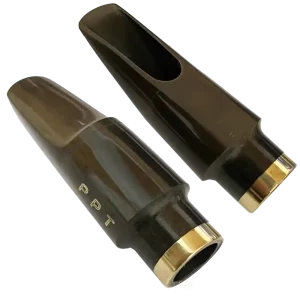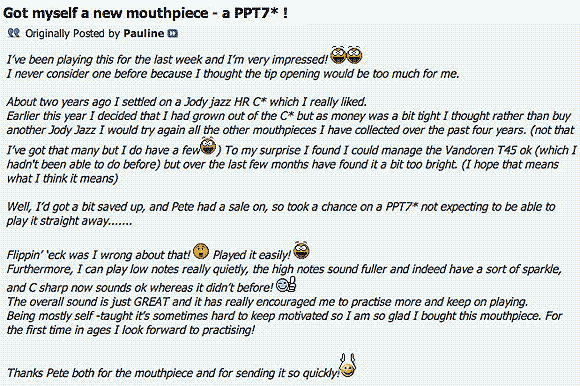The PPT Mouthpiece Story
Like many saxophone players I have been on a constant search for the ideal saxophone sound. I was after a mouthpiece that not only gave me something back, but at the same time allowed me to get my own sound (or rather sounds because I need a lot of versatility). For quite a long time I stuck with an Otto Link STM 7* on tenor, but although I was quite happy with the sound for some styles, I found it not quite versatile enough for my work as a session musician, so I started to look around and try different mouthpieces, including Lawton, Guy Hawkins, Wolf Tayne, Berg Larsen, Vandoren and Dave Guardala, all of which had something about them I liked, but none of which did everything I wanted. Was that too much to ask? No, so with the help of master craftsman and Acoustician Ed Pillinger I developed my own range: PPT mouthpieces.
Who plays PPT Mouthpieces?
(Video by Space Rehearsal & Recording)


-

PPT Soprano Mouthpiece
Price range: £195.00 through £260.00 Select options This product has multiple variants. The options may be chosen on the product page -

PPT Alto Mouthpiece
Price range: £210.00 through £250.00 Select options This product has multiple variants. The options may be chosen on the product page -

PPT Tenor Mouthpiece
Price range: £230.00 through £260.00 Select options This product has multiple variants. The options may be chosen on the product page -

PPT Baritone Mouthpiece
Price range: £270.00 through £290.00 Select options This product has multiple variants. The options may be chosen on the product page
What’s different about PPTs?
Historically mouthpiece makers aimed for consistency across the range, so their alto is like a smaller version of their tenor. But there is a big flaw here. Back in the golden age of jazz and R&B saxophone, tenor players found that Otto Link or Berg Larsen suited the tenor, alto players found that Meyer or Brilhart suited the alto. So for this very reason PPT tenors, altos, sopranos and baritones each have a different design to bring out the best whatever size saxophone you play. However I found that there was nothing that fitted nicely between a Link and. Larsen, so this was my goal – my quest for the holy grail of mouthpiece. The PPT tenor has a big chamber, and a baffle that took months to perfect. It can give a sparkle or edge to a sound that Otto link players have to really struggle to get but at the same time it is actually capable of real warm lushness that can be elusive with a Berg Larsen. We refined the concept of the Larsen baffle by using much smoother contours. And in the end it paid off. PPTs are molded from scratch using various composites chosen for strength, acoustic properties and of course, safety.
Materials
- Black HD Resin A high density hard rubber (ebonite) and bronze composite – very attractive pearlescent look
- Onyxite (custom orders only) – White stone powder resin composite.
Originally PPTs were available in dark blue or bronzite (a resin compound that includes bronze powder). MKII PPTs were made with a new composite, Onyxite, that included powdered stone. These are still available as a custom order. MKIII PPTs are Black HD Pearlescent (Resin), a brand new formula that includes bronze powder and hard rubber (ebonite). The density is designed to be the same as grenadilla wood which has the same sound but very slightly more conistent across the dynamic range. However when we talk about the sound of a mouthpiece material, it is often a very subtle difference – The basic sound of all resin PPTs is so similar that it is not realistic to differentiate via sound clips. Low baffle pieces (such as the alto and soprano) can have very slight differences between onyxite and HD resin, however the higher baffle mouthpieces such as the tenor do not. If we are able to accurately record any differences then sound clips will be posted.
Recommended ligatures:
- Marc Jean (contact manufacturer for exact PPT models)
- Baritone: (Rovner Bass Clarinet Dark 3RL or Light L10)
- Baritone: GF bass clarinet 05M BGG 13
- Tenor HD Resin: (Rovner Star HR tenor SS-2R)
- Alto 5 & 6: Any HR alto ligature (e.g. Rovner Star SS-1RL )
- Alto 8* Hooligan: Any Bb clarinet ligature
The inspiration behind the different models
Tenor
Think of a wilder Otto Link or an easier to control Berg Larsen. While developing it I was currently expoerimenting with vandorens and RPC to get that elusive sound and response I knew must exist somewhere so those pieces are also inspirations for the PPT tenor
Alto
This was a bit easier. We got hold of about 20 vintage Meyers, each was quite different and simply chose the best one and made a very close copy.
Soprano
This was based on a vintage Selmer Soloist, but with a lot of work done to the throat. Dimensions were tricky, because it was necessary to find just the right throat and chamber combination to sweeten the sound but without the intonation suffering.
Baritone
This was easy. I just happened to own the very best slant signature Link baritone mouthpiece. So we copied that. The Power is the same but with a similar baffle to the PPT tenor – a smoother semi-subtle bullet shape.
About the New “Hooligan” Models
We are finally very proud to offer a new line in PPT mouthpieces for those with no fear (of the neighbours) – the Power & Hooligan models. This has taken years in research and development. Originally made with purple resin, these are now also available in black HD pearlescent (resin).
Hooligan by Name, Hooligan by Nature
Wild, bright, dirty gritty and totally irresponsible. But of course in the right hands it can be tamed. But maybe tamed is the wrong word – this is unlikely ever to sound tame, however you should be able to bend it to your will without losing any hooliganality. On to the sound concept. I was not just after a bright, edgy “paint peeler” – there are plenty of those around. One of the things saxophone players seek in a blues or rock mouthpiece is an elusive kind of sound that I call “grit,” and a truly gritty sound is what we are aiming for with this mouthpiece. Of course the player him or herself can supply that, but it really does help if the mouthpiece is amenable. Otherwise attempts to add grit can often just sound overblown and have a tendency to sound flat.
Inspiration for the Hooligan Alto
We started out working on the alto version. Originally we thought of taking a typical “holy grail” New York Meyer Brothers type mouthpiece and adding a baffle. Sounds easy, but that didn’t quite work in the way we wanted. One reason this has taken so long in development is that getting the perfection you strive for is not an exact science. A lot of trial and error is involved getting not just the right baffle and chamber combination, but the best facing curve. All these factors contribute to what makes it work the way we want. We only produce the alto with a wide 8* facing, as that is the facing that works best in combination with the chamber and baffle, however custom orders are of course possible for different facings.
So what is the Power?
The Power is a sort of slightly less bright design and we use if for the baritone where often want not quite so much edge. You can still get the edge, but it’s just more of a baritony sort of edge.Plenty of grunt and fatness. It is maybe slightly better behaved than the Hooligan, but still capable of some bad behaviour. Of course you can get a really hooligan baritone if you want (at your own risk) via a custom order.
“First impressions. I love the way the mouthpiece looks, and it is beautifully finished for a prototype. Fortunately had an old 2 screw Lig that fit. Spent about half an hour going back and forth between my 10MFan Boss and the Hooligan. Tried a 2 1/2 Bass Clarinet and 3 and 3 1/2 Tenor Sax Legere Signature Reeds. Facing curve works well on all 3 no quackiness or other oddities. As expected the 3 is easier at this stage to go quietly down low but was a little more fussy on altissimo. A few hours of get to know are in order. Sound wise my first impressions are its not quite as raspy as my Boss can be but offers a wider palette in the more civilized range of sax noises. I use a 10MFan Robusto for section work which is a great section mouthpiece. Mid point of the soundscape of the PPT is between the two others. Time will tell, but I think the altissimo on Pete’s piece is capable of being a little fuller if not overblown. Both Boss and PPT can shriek up there if pushed. Again first impressions but I think the PPT Hooligan has the widest sound palette of any mpce I have played so far. Intonation on my SML Gold Medal 1 requires a wee bit less correction on the PPT than the Boss which indicates to me that the mpce and SML are a great match. Big bore horn and big open mpce. Nicely free blowing which Suits my style. A few hours of long tones at the bottom and altissimo ends will tell the tale. Oops forgot to add, it’s nicely balanced across the range of the horn.” Jazzaferri (PPT Tenor Hooligan prototype)
Inspiration for the Hooligan Tenor
This one goes to 11. The tenor is closer to the standard PPT in that the baffle is very similar, and in spite of the huge tip (11) is surprisingly easy to blow. For intense rock and roll, this allows you to really push the sound into overdrive, with a huge growl that doesn’t force the flatness you often get when pushing so much air into the instrument.
Audio
Alto
Cafe Blues Strictly Mambo A Minor Blues Hooligan Blues (Hooligan) The Other Side of the Lounge (Hooligan) Alto 6** Noodling in A Alto 6** Noodling in Dm
Soundfile by David Roach
Tenor
Another Night – Tenor Resin Harlem Nocturne – Tenor Resin Evening Blues – Tenor Metal TCL – Tenor Metal
Baritone
Blackjack Jump – Baritone Power Walk the talk – Baritone Signature Big Girls Blues – Baritone Signature Lowdown Blues – Baritone Signature
Soprano
Love Them Soprano Blues Noodling on Soprano Soprano 1 Soprano 2
-

PPT Soprano Mouthpiece
Price range: £195.00 through £260.00 Select options This product has multiple variants. The options may be chosen on the product page -

PPT Alto Mouthpiece
Price range: £210.00 through £250.00 Select options This product has multiple variants. The options may be chosen on the product page -

PPT Tenor Mouthpiece
Price range: £230.00 through £260.00 Select options This product has multiple variants. The options may be chosen on the product page -

PPT Baritone Mouthpiece
Price range: £270.00 through £290.00 Select options This product has multiple variants. The options may be chosen on the product page




